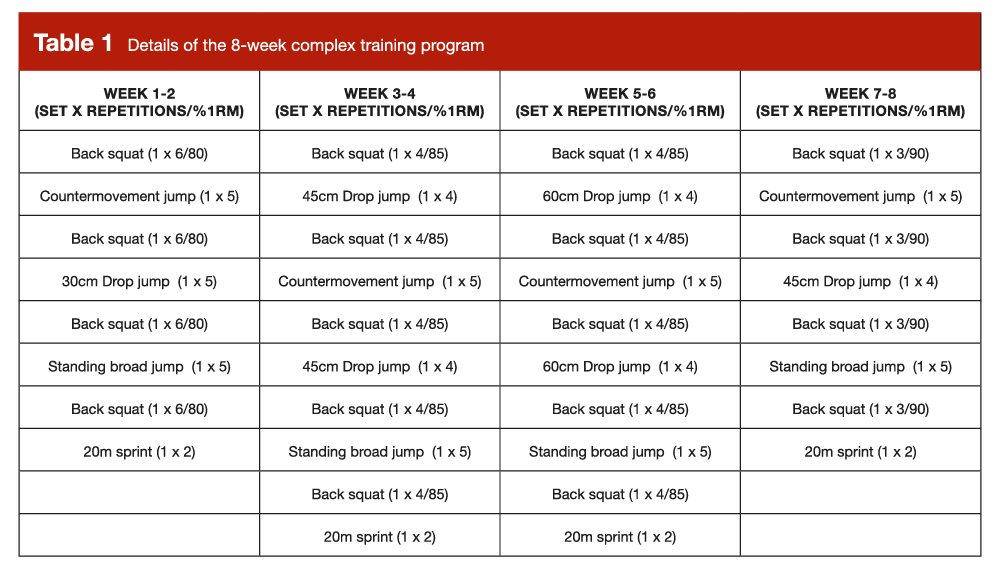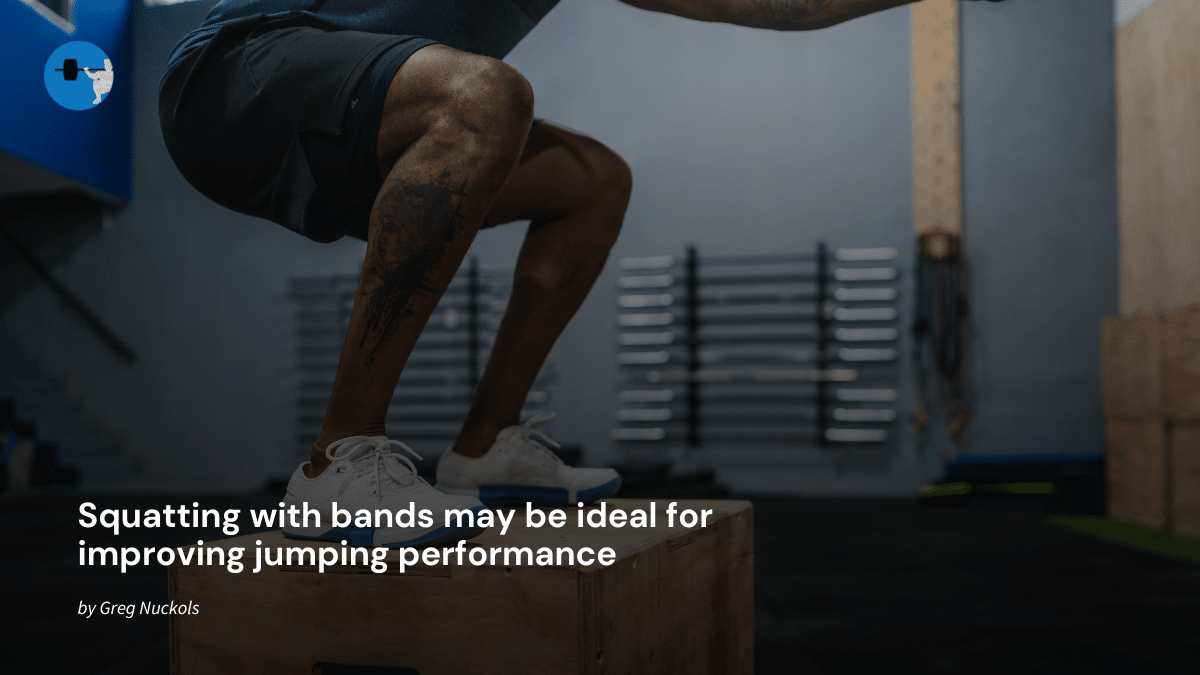There’s a reason why we haven’t written much about training with bands, in spite of the fact that training with bands is still somewhat popular: there just hasn’t been much longitudinal research on the topic lately. There have been a few studies looking at acute effects (things like bar velocity, power output, post-activation potentiation, and electromyographic measures within a single training session), but I think a 2018 meta-analysis by dos Santos and colleagues really put the brakes on longitudinal studies. That meta-analysis found that variable resistance training (training with bands or chains) didn’t lead to larger strength gains than training with plain old metal plates, and I suspect that many sports scientists didn’t want to invest a ton of time into studying an intervention that was likely to end with null results.
With that said, there’s a major application of training with bands that’s (weirdly) under-researched: training for power output and explosiveness. Training with bands or chains seems like it would be ideal for improving jumping performance. When you’re training for maximal strength, you’re ultimately limited by your ability to produce force through a specific (rather small) “sticking region” of a particular lift. Both bands and straight weight can present a near-maximal challenge to the lifter through the sticking region, so it makes sense that they’re similarly effective for promoting maximal strength (assessed via 1RMs of barbell exercises). However, jump performance is dictated by your ability to produce force rapidly through a much longer range of motion: you start accelerating your body at the start of the concentric phase of a jump, and you need to rapidly apply force until the moment your feet leave the ground. With traditional barbell exercises, the top part of the range of motion is typically pretty easy – you can ease up after you make it through the sticking region, and still complete the lift. With bands, on the other hand, the effective load on the bar increases as you progress through the concentric phase of the squat, requiring more effort through a larger portion of the concentric phase than you’d experience with straight weight. Thus, squatting with bands seems like it should be a more specific stimulus than squatting with straight weight for the purpose of improving jump performance.
With that in mind, the present study by Shi and colleagues aimed to compare the effects of squatting with straight weight versus squatting with bands for improving maximal strength and explosive performance. 21 collegiate basketball players completed this study. Lack of resistance training experience wasn’t an exclusion criterion, but most collegiate basketball players have spent at least a bit of time in the weight room, and the subjects squatted approximately 125kg (275lbs) pre-training, so I suspect that all of the subjects had some prior resistance training experience.
Subjects were randomized into two groups that each completed an eight-week training program, with two training sessions per week. Pre- and post-training, researchers assessed subjects’ maximal squat strength (1RM), countermovement jump height, squat jump height, standing broad jump distance, and 10-20m sprint times. The training sessions focused exclusively on lower body strength and power development, and consisted of complex training (one set of a strength exercise, followed by one set of a plyometric or high-velocity exercise). Subjects rested 3 minutes after each set of squats, and 4 minutes after each set of jumps. Details of the training program can be seen in Table 1.

One group of subjects completed all of their squats with straight weight: just a barbell and metal plates. The other group of subjects replaced a portion of the load with resistance from elastic bands that were anchored to the floor and looped over the barbell. The resistance provided by the bands was approximately 35% of 1RM at the top of the lift, and approximately nil at the bottom of the lift. Since the resistance provided by the bands (averaged over the entire range of motion) was about 17% of 1RM, the load provided by metal plates was reduced by approximately 17% of 1RM to equalize the total loading between the groups.
For example, if a subject had a 200kg squat 1RM, and they were training with 80% of 1RM, they’d just use 160kg if they were in the straight weight group. If they were in the bands group, the bands on the bar would provide approximately 70kg of resistance at the top of the lift (200 × 35%), and virtually no resistance at the bottom of the lift. The average resistance provided would be 35kg, so the load on the bar would be reduced by 35kg. So, they’d complete their set of squats with 125kg of straight weight (from the barbell and metal plates), plus the bands. The total resistance would be approximately 195kg at the top of the lift, and 125kg at the bottom of the lift, for an average resistance of 160kg.
The results of the study were pretty straightforward: squatting with bands improved vertical jumping performance more than squatting with straight weight. The difference was statistically significant for squat jump improvements (+21.4% vs. +12.9%; p = 0.008), but not quite statistically significant for countermovement jump improvements (+12.9 % vs. +5.6%; p = 0.056). Changes in all other outcomes were similar between groups: large increases in squat 1RM, small increases in broad jump distance, and minimal changes in 10m and 20m sprint times. You can see these results in Figure 1 and Table 2.


The results of this study comport well with studies by Katushabe and Kramer and by Joy and colleagues. Katushabe and Kramer studied male soccer players over 6 weeks, and found that squatting with bands tended to improve squat jump height to a greater extent than squatting with straight weight (+2.67cm vs. +1.38cm; p = 0.055). Like the present study, other measures of explosive performance didn’t differ between groups – changes in 40m sprint times and performance in an agility drill were similar between groups. Joy and colleagues studied collegiate basketball players with at least one year of resistance training experience over 5 weeks. They also found that training with bands tended to result in larger increases in vertical jump height, maximal power (assessed during vertical jumping), and rate of power development than squatting with straight weight. Furthermore, improvements in 40-yard dash times didn’t differ between groups.
However, a study by Andersen and colleagues attained different results that were nonetheless illuminating. Trained women completed 10 weeks of training, and completed countermovement jump tests at three different depths: descending until they achieved approximately 60°, 90°, and 120° of knee flexion. Improvements in countermovement jump height didn’t significantly differ between groups, but the nominal increase was larger in the band group at 60° of knee flexion (+3cm vs. +2.6cm), and larger in the straight weight group at 90° and 120° of knee flexion (+1.9cm vs. +2.9cm, and +1.5 vs. 2.4cm).
I suspect that the study by Andersen and colleagues obtained different results, primarily due to differences in the band resistance used in these four studies. In the present study by Shi and colleagues, band tension was 35% of 1RM at the top of the lift, and ~0% of 1RM at the bottom. In the study by Joy and colleagues, band tension was 30% of 1RM at the top of the lift, and ~0% of 1RM at the bottom. In the study by Katushabe and Kraemer, they report there was “20% of load coming from the power bands, and the difference coming from the weight plates” (which is somewhat vague, but appears to be within the same general ballpark as the Shi and Joy studies). However, band resistance accounted for more than 40% of the total resistance in the Andersen study: 58% of the resistance at the top of the lift and 44% of the resistance at the bottom of the lift at the start of the study, and 38% of the resistance at the top of the lift and 27% of the resistance at the bottom of the lift by the end of the study.
When you squat with a lot of band tension, you can completely transform the typical resistance curve of a squat. When band tension is dialed in just right, you wind up with a smooth resistance curve that matches your natural strength curve pretty well, resulting in a consistent, high level of effort throughout the lift. With excessive band tension, on the other hand, the feel of the lift is completely inverted: instead of being hard at the bottom and easy at the top (as it would be with straight weight), the lift becomes easy at the bottom and very hard at the top. With heavy enough band tension, you may hit your sticking point when you’re in a quarter squat position.
Through that lens, the results of the Andersen study make a lot of sense – they comport well with the principle of specificity, and don’t actually conflict with the results of Shi, Joy, and Katushabe. The subjects in the band group in the Andersen study experienced pretty large increases in countermovement jump performance at 60° of knee flexion, because that matches the range of motion where they were actually being challenged by their squat training. However, they experienced smaller improvements at 90° and 120° of knee flexion because their squat training wasn’t providing quite as much of a challenge at deeper knee flexion angles. In the other three studies, band tension was high enough to still provide more of a challenge than straight weight through the top portion of the concentric phase, but not so high that the bottom portion of the concentric became meaningfully easier.
Overall, we can take three things away from the research on squatting with bands:
- Squatting with bands doesn’t increase your 1RM squat to a greater extent than squatting with straight weight, on average.
- Squatting with bands probably does increase your jumping ability to a greater extent than squatting with straight weight. However, using bands probably doesn’t increase your performance in less specific tests of power output and explosive performance (sprinting, broad jumps, or change of direction) to a greater extent than squatting with straight weight. Both of these findings comport well with the principle of specificity.
- Excessive band tension can be counterproductive. Using band resistance equal to ~30-40% of 1RM at the top of the lift (and virtually no resistance at the bottom of the lift) to replace an amount of plates equal to 15-20% of 1RM seems to get the job done. More band tension beyond that point is unlikely to further improve results, and may actually result in smaller improvements in jump performance.
To be clear, these takeaways are somewhat tentative. Four studies isn’t a huge body of literature, and while the outcomes related to jump performance certainly lean in favor of squatting with bands, only a handful of the differences between groups achieved statistical significance, and we’re also not dealing with enormous effect sizes. However, I’m a bit more willing to interpret these results liberally because they fit well within the firm conceptual framework of the principle of specificity. With that said, a more conservative wait-and-see approach to interpreting these results is certainly still very justifiable.
Note: This article was published in partnership with MASS Research Review. Full versions of Research Spotlight breakdowns are originally published in MASS Research Review. Subscribe to MASS to get a monthly publication with breakdowns of recent exercise and nutrition studies.




